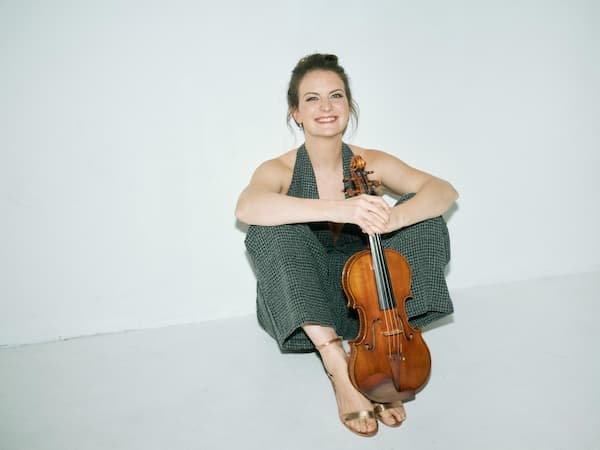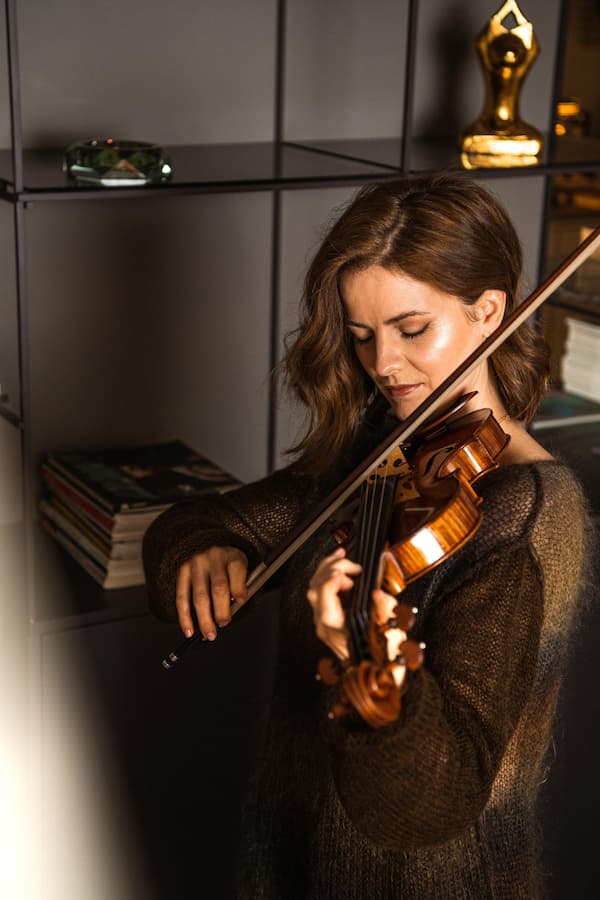The ‘Mount Everest’ of Violin Concerti

Veronika Eberle © Stefan Grau
German violinist Veronika Eberle is a musician whose unique blend of virtuosity and sensitivity makes her one of the most in-demand performers of her generation. Aged just 16, she gave her Salzburg Festival debut playing Beethoven’s violin concerto with Sir Simon Rattle and the London Symphony Orchestra, and since then, Veronika has played with orchestras including the New York Philharmonic, Gewandhaus Orchestra, Tonhalle Orchester Zurich, and the Concertgebouw and Montreal Symphony Orchestras, among many others.
Beethoven: Violin Concerto in D Major, op. 61 | Sir Simon Rattle and Veronika Eberle
Veronika is an artist whose vibrant and engaging performances have led to appearances with some of the finest orchestras around the world, and whilst her feet are firmly planted in masterful command of the standard repertoire, one eye is always on the future: Veronika recently commissioned renowned composer and clarinettist Jörg Widmann to reinvent the cadenzas of the Beethoven violin concerto.
Veronika recently recorded the Beethoven concerto, completely with Widmann’s electrifying new cadenzas, with the London Symphony Orchestra and Sir Simon Rattle. I chatted with her about the genesis of this project and, amongst other things, her love-at-first-sight encounter with the violin, aged just five years old.
How did you find your way to music? Do you come from a musical family?
My parents are both doctors. My grandfather was also a doctor, but he led the church choir and played the organ, so music was around when I was younger.
When I was around 5, I went to a music school, and my friend had just started playing the violin. I saw it and really fell in love with the instrument. I thought, ‘Ok, this is it, I want to learn the violin.’
I came to my parents, and they said, ‘Why the fiddle? Why this instrument? We have a piano at home, don’t you want to play the piano first?’
I was quite fixed on the violin, and I kept asking for it. My mum said, ‘Ok, let’s make a deal: we do one piano lesson, and if you really don’t like it, then I will look for an instrument for you.’ Obviously, I went to this lesson already knowing I wouldn’t like it! So I came back and started the violin.
My grandfather had a violin in his house in one of those rooms that no one ever goes – he came to our house a couple of days later with the violin, and there’s a photo somewhere of me in the garden with this huge full-sized instrument in my arms. It was way too big for me, but I was so happy and proud, and my parents took it from there.
Who inspired you growing up?
I was very lucky with my first teacher. He showed me the wonder of music. It was quite special, and I think that for smaller kids, this is so important. It’s not just about learning how to hold the bow; a good teacher is already giving you something, and you start to discover how amazing music is and what a new language you’re learning.
He was very supportive throughout. I studied with him for two years here in Bavaria, and then when I was 8, I started lessons in Munich with a teacher at the university there.
J. S. Bach: Violin Partita No.2 in D minor, BWV 1004 | Veronika Eberle | Konzerthaus Berlin
You made your debut at the Salzburg Festspielhaus at 16, with Sir Simon Rattle and the London Symphony Orchestra. How did that feel?
I met Simon for the first time when I was 14, and I remember it very vividly and fondly. From the moment he opened the door I felt his generosity, his love and passion for music.
He sat down on the piano and asked what I’d brought (it was the Mozart A major concerto). We played together, and it was super warm from the first moment. Then I played some Bach, I think the G minor solo sonata, and from that moment, I was lucky that from time to time I could come and play for him.
At some point, I had played the Beethoven concerto for Simon, just to discover and study a little bit, and a couple of weeks later, he called me.
I was at school, and when I came home I had a voicemail on my phone from him. I called him back and he asked if I wanted to play the Beethoven concerto with him and the LSO in Salzburg. I was absolutely overwhelmed and replied that yes, of course I wanted to!
When one is 16, it doesn’t seem like such a huge thing. Obviously, it was, but you don’t really get frightened. I could just really enjoy it. It was very special, and I was so, so grateful.
I remember when the orchestra started the second movement, I will never forget the sound. I got goosebumps just listening to them.
This concerto is a piece that is very close to your heart?

Veronika Eberle © Louie Thain
I recorded it with Simon and the LSO recently. It was my first ever recording, and it was pretty clear that I wanted to do this concerto. It is so special to me in my life, but also just as a piece for us as violinists: it’s the Mount Everest.
I was living with the Beethoven for many years. Some years, I would play it more, some years I left it, but it was still growing, and your view on it changed, so it was still following me.
You commissioned Jörg Widmann to write new cadenzas for your performances (and recording) of the Beethoven Concerto. Can you tell us how that came about?
It came up when we were talking about the LSO recording. I thought about which cadenza I would record because I’ve played different ones over the years. I was trying out Kreisler’s, which is the one every violinist takes on. It’s fantastic, but it’s from the Romantic Period, so it’s a very different statement.
Then I adapted my own original version of the Beethoven cadenza, which he wrote for piano, but I always had that feeling that it wasn’t really for the violin. So I thought, ‘Ok, what is missing in this whole cadenza world is the view on it from our time.’
I think this concerto is still so present and so up-to-date, and it’s very modern, in a way. I thought Jörg Widmann would be the one who could do an amazing job and write something for us.
I remember when I met him for the first time we played together in Heimbach, at the Spannungen festival a few years ago. We shared a long car journey together, and back then, already we talked about Beethoven. Jörg told me how madly he admires Beethoven and how he was his big hero, so I thought if I ask someone to write a Beethoven cadenza, I will ask him.
It was during the pandemic that I contacted Jörg and asked him about this idea. At first, he said the concerto was untouchable, that it was so perfect that he could only ruin it. We talked for quite a long time about what I had in mind for how it could be – whether it would be modern or in the style of the time, or a mixture – and then he said, ‘Let me think about it.’
Three days later, I got a message from Jörg, and he was completely on fire! He said he was going to do it, that he was already writing it and had all these ideas. I think what he wrote is just brilliant. He takes all the material from the concerto, and you see how he connects the first and third movements, like Beethoven did in the symphonies, while still bringing in his own language and colours.
There is a continuation of Beethoven’s ideas, but he also drives it far, sometimes – there is a duo with the double bass which starts to go towards jazz. I think it’s brilliant. In the first movement, when the cadenza ends, Jörg puts some of Beethoven’s material into other instruments of the orchestra, so you don’t know whether it’s Beethoven or Widmann.
In the second movement there’s a moment where there’s a duet between the solo violin and the concertmaster. We were talking about this unbelievable moment where Beethoven writes perdendosi, where everything fades away, and I think in this concerto, these most quiet moments are the most special, actually. I just love how Jörg expands this idea in the cadenza.
And now it’s published: two weeks ago, I got the published music, and I hope a lot of violinists take these cadenzas on and perform them.
How does it feel in performance to integrate this new material into such a well-known piece?
It’s quite a challenge to perform, I must say. It’s long, it’s demanding, and it also needs a different way of playing to [playing] Beethoven. But for me, I find that you start to listen to the piece in a different way. I’ve had that reaction from audiences too. I think that makes it very special.
What do you do in your spare time when you are not commissioning cadenzas?
I’m a mother of a four-year-old boy, so he takes a lot of time. It’s fun, and I enjoy it a lot. I live outside of Munich in the countryside, so I really love to go into nature, do sports, and just be outside. I think it’s nourishing me a lot at the moment.
My child often comes on tour with me, and it’s a bit like with the Widmann cadenzas: with a child around, you start to see cities in a different light!
For more of the best in classical music, sign up for our E-Newsletter




